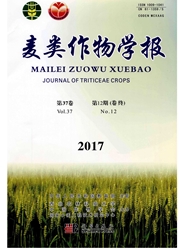

 中文摘要:
中文摘要:
为研究利用近红外光谱技术鉴定春小麦单粒种子活力的效果,以2013年收获的甘肃春小麦品种宁春4号种子为材料,对300粒小麦种子进行近红外光谱单粒扫描,根据光谱图结合发芽实验结果建立春小麦种子活力预测模型。结果表明,以腹面和背面平均光谱的建模效果要优于单面光谱。最佳建模比例为建模集与检验集之比3∶1。应用近红外光谱定性偏最小二乘分析方法建模,在7 000~8 000cm-1光谱范围内采用中心化预处理,在主成分为5时,模型的建模集和检验集的鉴别率分别为86.36%和91.30%,建模效果最佳;采用近红外光谱偏最小二乘法定量检测小麦种子活力时,建模效果较差。因此,近红外光谱定性偏最小二乘分析方法适于进行春小麦单粒种子活力定性鉴定。
 英文摘要:
英文摘要:
To optimize the identification of single seed vigor by near infrared spectroscopy,Ningchun 4seeds harvested in Gansu in 2013 were selected as sample.Spectrums of 300 single seeds were collected by Fourier near-infrared spectrometer,combing with the results of the germination experiments.The results showed that the modeling based on the average spectrum at both sides was better than that based on single side of one seed.The best ratio between calibration and validation sets was 3∶1.By using distinguished partial least squares(DPLS)and centralized pretreatment method,the best modeling performed that the identification rates of the calibration and validation sets were 86.36% and91.30% with the spectrum range from 7 000cm-1 to 8 000cm-1 and the main component was 5,respectively.The quantitative partial least squares(QPLS)modeling based on fresh weight could not be used for seed vigor analysis.DPLS based on Near-infrared spectroscopy is suitable to analyse the single seed vigor of spring wheat.
 同期刊论文项目
同期刊论文项目
 同项目期刊论文
同项目期刊论文
 期刊信息
期刊信息
